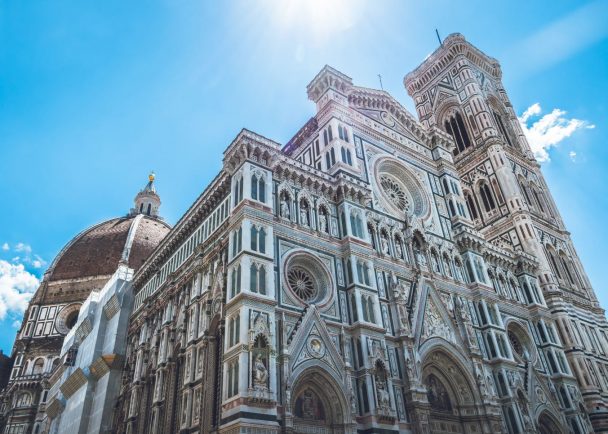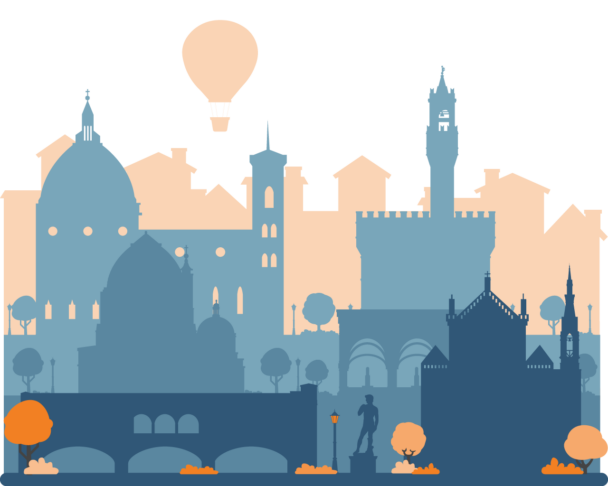Description
The city of Florence – often called the “Cradle of the Renaissance” – is home to some of Western civilization’s greatest works of art and architecture.
Let’s travel through the centuries to discover masterpieces by Florence’s praised painters, sculptors, inventors, and theorists – from Giotto to Michelangelo.
Included in the program: Guided Tours and entrance to Museums such as Galleria degli Uffizi, Opera del Duomo, and others.
Topics included in the course:
- Overview of Renaissance art and architecture in Florence and the ‘rebirth’ of beauty, truth, and wisdom;
- Florence’s beginnings, starting with its foundation as a Roman colony;
- The development of humanism and the progressive mindset;
- Early Renaissance in Florence: Masters of the 14th and 15th centuries, from Cimabue to Botticelli;
- The role of patronage in Renaissance art, the Medici family, and the Platonic Academy;
- Late Renaissance in Florence: Art history’s famous competing geniuses, Leonardo da Vinci and Michelangelo;
- An introduction to Mannerism.
What is included
Learning outcomes
Participants of this course will learn to:
- Provide historical context for topics concerning Italian Renaissance art;
- Guide students in the interpretation of artworks in order to strengthen their visual thinking skills;
- Lead students in art activities inspired by classical works of art.
Tentative schedule
Day 1 – Course introduction & precursors to Renaissance art
Course introduction
- Introductions and presentations of participants’ schools.
Precursors to Renaissance art in Italy
- Precursors to Renaissance art in Italy: Roman, Romanesque, and Gothic art and architecture;
- Florence’s beginnings, from its foundation as a Roman colony to the wool trade, to the introduction of a banking network;
- Visit San Miniato al Monte with a panoramic view of Florence. Romanesque architecture, mosaics, and Byzantine iconography.
Day 2 – Florence during the Middle Ages and the shift to naturalism
- 14th-century Florence: The Black Death, Boccaccio, and The Decameron; Petrarch and humanism; Cimabue and Giotto;
- Early Renaissance in Florence: Naturalism and the art of sculpture: Donatello, Brunelleschi, Ghiberti and the Gates of Paradise;
- Visit to Basilica di Santa Croce: Cimabue, Giotto, Brunelleschi, Donatello.
Day 3 – The rediscovery of perspective
- Drawing, painting, the rediscovery of perspective, and the chiaroscuro technique: Brunelleschi, Leon Battista Alberti, Masaccio, and Paolo Uccello;
- Visit Basilica di Santa Maria Novella with art activity in the cloisters.
Day 4 – Neoplatonism and symbolism in art
- Visit San Marco Museum: Michelozzo, Fra Angelico, Ghirlandaio, Girolamo Savonarola, and the campaign for Christian renewal;
- The role of patronage in Renaissance art, the Medici Family, and the Platonic Academy. Botticelli, symbolism, and storytelling through painting;
- Late Renaissance in Florence: Leonardo da Vinci, Michelangelo, and Raffaello.
Day 5 – Mannerism
- Introduction to Mannerism with visits to the Bargello Museum and Loggia dei Lanzi;
- Visit to Museo dell’Opera del Duomo;
- Group brainstorming: How to incorporate Renaissance art history into classroom activities. Suggestions of low-cost art projects inspired by classical art.
Day 6 – Course closure and cultural activities
- Course evaluation: summary of acquired competencies, feedback, and discussion;
- Awarding of the course Certificate of Attendance;
- Final visit to the Uffizi Gallery Museum.




